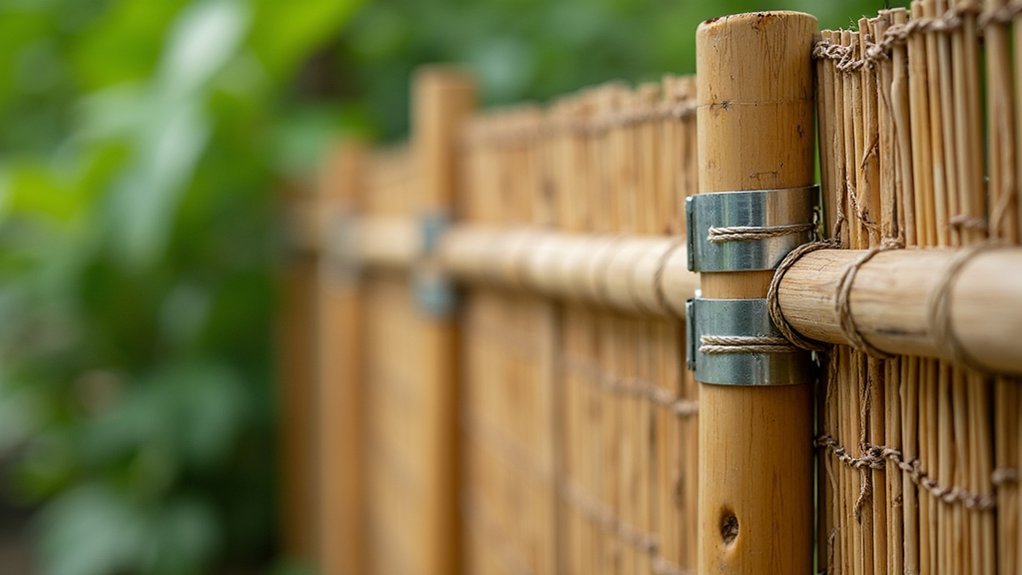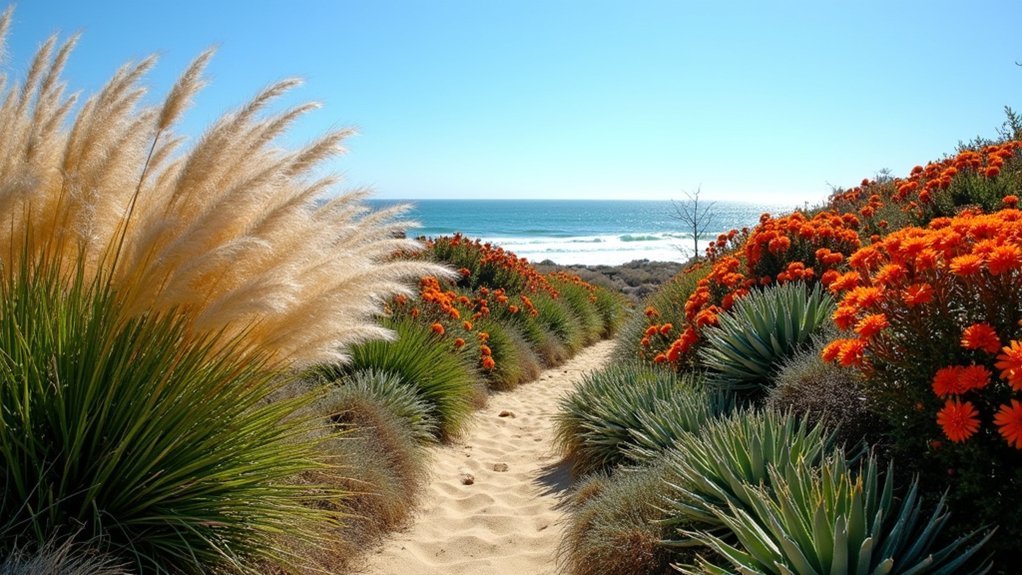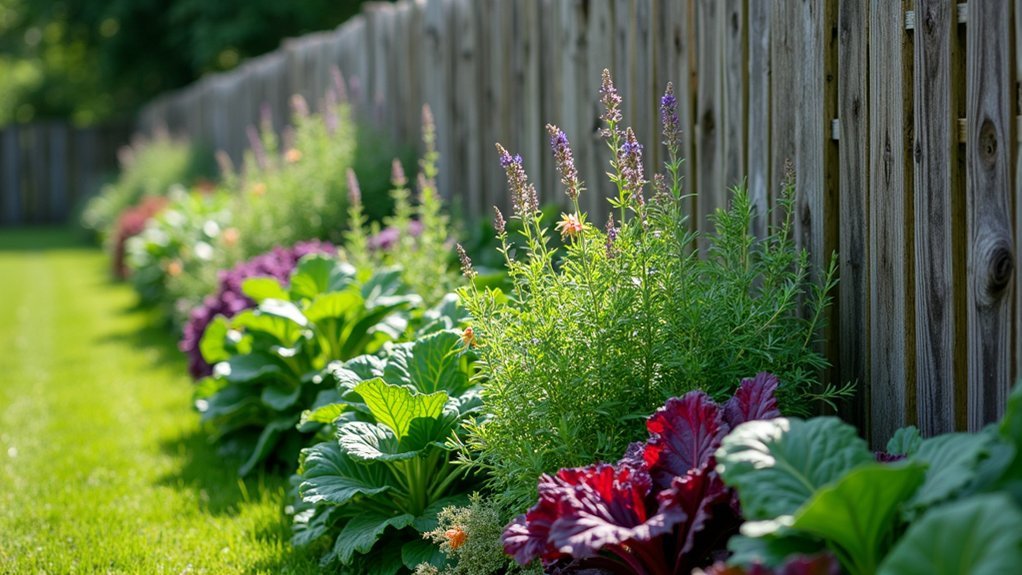Bamboo fence panels can be reinforced with several durable materials for longevity. You’ll find stainless steel or galvanized wire ideal for basic structural support, while copper wire offers aesthetic appeal with corrosion resistance. For coastal installations, choose 316-grade stainless steel or marine-grade copper wire. Modern options include hidden fastener systems and polyurethane adhesives for flexibility. Traditional Japanese binding techniques like Otoko Musubi enhance both strength and visual appeal. These reinforcement choices greatly impact your fence’s durability and appearance.
Essential Metal Reinforcements for Bamboo Fence Durability

When building a bamboo fence that will stand the test of time, selecting the right metal reinforcements is essential. Steel support poles provide the backbone of your installation, creating a sturdy framework that prevents sagging and collapse over time.
You’ll need to choose the appropriate binding material based on your environment. In coastal areas, opt for aluminum wire, which resists corrosion while remaining lightweight.
Galvanized wire offers a cost-effective alternative that still provides excellent durability. For premium installations, consider copper wire for its aesthetic appeal and long-lasting performance.
In harsh weather conditions, high-tensile steel wire delivers superior strength. The tensile strength of properly reinforced bamboo fencing can rival that of traditional steel barriers while offering a more natural aesthetic.
Whatever metal reinforcement you choose, it will greatly extend your fence’s lifespan while maintaining structural integrity through changing seasons and weather conditions.
Traditional Japanese Binding Techniques for Secure Fencing
Unlike modern fastening methods, traditional Japanese binding techniques transform bamboo fencing into both functional structures and works of art. The Otoko Musubi (Man Knot) and Ibo Knot provide exceptional strength while enhancing the fence’s visual appeal.
The timeless artistry of Japanese bamboo binding marries uncompromising structural integrity with profound aesthetic sensibility.
You’ll find these techniques particularly evident in Yotsumegaki and Shibagaki fence styles.
To achieve authentic Japanese bamboo binding:
- Soak your hemp twine or palm fiber rope in water first—this makes the material pliable and results in tighter knots as it dries
- Implement crisscross patterns when securing horizontal and vertical pieces for maximum stability
- Consider adding decorative knots at fence corners for both reinforcement and aesthetic enhancement
Regular maintenance, including inspecting and replacing worn bindings, guarantees your traditionally bound fence remains beautiful and sturdy for years. The traditional Oka Musubi or Japanese square knot is especially effective for securing bamboo fence joints with proper tension.
Optimal Fastening Systems to Prevent Panel Movement

Securing bamboo fence panels properly can mean the difference between a lasting installation and constant repairs. Modern hidden fastener systems like Snap&Stay technology offer clean aesthetics by internally locking panels without visible hardware.
For maximum stability, use stainless steel screws that resist rust or marine-grade adhesives in moisture-prone areas. The FenceTrac system provides exceptional support for bamboo panels while protecting against moisture damage. Install panels vertically to maximize bamboo’s natural strength, and reinforce panel junctions with metal corner brackets to prevent lateral movement.
You’ll find that pre-drilled bamboo panels streamline your installation with standardized hardware positioning. Consider implementing a double-fastener strategy at stress points, combining mechanical fasteners with adhesives.
For areas with seasonal changes, choose adjustable tension systems that accommodate bamboo’s natural expansion and contraction while maintaining structural integrity.
Weather-Resistant Wire Options for Coastal Bamboo Installations
When constructing bamboo fences in coastal environments, you’ll need marine-grade copper wires that resist salt corrosion while providing exceptional longevity.
Salt-resistant galvanized options offer a cost-effective alternative that still protects against the harsh effects of sea spray and constant humidity. Some products use nylon coated wire to prevent rust and eliminate unsightly metal exposure in bamboo fence installations.
For maximum durability, consider stainless steel reinforcement which, though more expensive, will outlast other materials in aggressive coastal conditions.
Marine-Grade Copper Applications
Three key factors make marine-grade tinned copper wire essential for coastal bamboo fence installations. The tinned copper construction actively resists saltwater corrosion and prevents oxidation, while Type III finely stranded conductors enhance flexibility in high-wind environments.
Its PVC insulation withstands temperatures from -4°F to 221°F, making it ideal for extreme coastal weather cycles. The 600 volt rating provides ample capacity for any electrical components integrated into bamboo fence designs.
When selecting wire for your bamboo fence project, consider:
- 14 AWG handles 35A outside engine spaces, perfect for security lighting integration
- Fine stranding enables tighter bending radii around bamboo joints without damage
- UV-stabilized jackets prevent insulation cracking from constant sun exposure
Always use zinc-coated hardware when attaching terminals to prevent dissimilar metal corrosion, and apply dielectric grease on connections to further protect against salt spray.
Salt-Resistant Galvanized Options
Although marine-grade copper offers excellent protection, salt-resistant galvanized wire provides a cost-effective alternative for coastal bamboo fence installations. The zinc coating creates a protective barrier that shields the underlying steel from corrosion, extending your fence’s lifespan in challenging coastal environments. This reinforcement technique is similar to what’s used in split-bamboo fencing where galvanized wire interweaves with bamboo canes to create durability.
| Wire Type | Corrosion Resistance | Cost Factor | Lifespan in Coastal Areas |
|---|---|---|---|
| Standard Galvanized | Moderate | $ | 3-5 years |
| Heavy-Duty Galvanized | Good | $$ | 5-7 years |
| PVC-Coated Galvanized | Very Good | $$$ | 7-10 years |
| Aluminum Alternative | Excellent | $$$$ | 10+ years |
While galvanized options will eventually degrade in high-salt conditions, you’ll get significant protection compared to untreated wire. For maximum longevity, consider PVC-coated galvanized wire, which adds an extra defensive layer against salt spray and moisture.
Stainless Steel Reinforcement
For ultimate protection in coastal environments, stainless steel wire stands as the gold standard for bamboo fence reinforcement. The corrosion-resistant properties make it ideal for areas exposed to salt spray and high humidity, ensuring your fence maintains its structural integrity for years without deterioration.
When selecting stainless steel reinforcement, you’ll find various options to match your specific needs:
- 316-grade stainless steel – marine-grade quality that withstands the harshest coastal conditions
- Wire mesh integration – provides additional security while maintaining the natural bamboo aesthetic
- Tensioning systems – allow you to adjust tightness as needed, especially after storms
You’ll appreciate the minimal maintenance requirements while enjoying peace of mind that your bamboo fence won’t succumb to coastal weathering effects, even during severe weather events. Modern bamboo fence panels feature a protective plastic coating that significantly enhances antirust performance even in challenging marine environments.
Modern Adhesives and Their Role in Fence Reinforcement
Modern adhesives offer superior reinforcement options for your bamboo fence panels, with polyurethane providing flexibility during temperature changes while epoxy delivers maximum bond strength.
You’ll find that weather-resistant formulations like UV-resistant polyurethane and hybrid polymers maintain their integrity even in coastal environments with high salt exposure and humidity.
These adhesives enable concealed connection techniques that preserve your fence’s natural aesthetic while creating stronger, longer-lasting panels than traditional mechanical fastening methods. When selecting adhesives, remember to thoroughly clean the surface first to ensure maximum bonding capability and durability of your installation.
Polyurethane vs. Epoxy Benefits
When reinforcing bamboo fence panels, choosing the right adhesive greatly impacts durability, appearance, and structural integrity.
Polyurethane offers superior flexibility for bamboo’s natural movement and excellent UV stability, preventing yellowing in outdoor settings. It’s also more cost-effective for larger fence projects. Polyurethane effectively fills gaps around bamboo poles and joins, creating waterproof seals that prevent moisture damage over time.
Epoxy, however, provides exceptional structural strength and chemical resistance, making it ideal for load-bearing sections or areas exposed to harsh conditions.
Consider these factors when selecting your adhesive:
- Flexibility needs: Choose polyurethane for panels in areas with temperature fluctuations or ground movement.
- Structural requirements: Select epoxy when maximum bonding strength is critical.
- Environmental exposure: Opt for polyurethane in direct sunlight, but epoxy for chemical exposure areas.
You’ll achieve ideal results by matching the adhesive to your specific bamboo fence requirements.
Weather-Resistant Bonding Solutions
Creating a weather-resistant bond between bamboo elements remains one of the biggest challenges in fence construction, particularly in regions with extreme climate variations.
You’ll find polyurethane-based adhesives offer the ideal combination of flexibility and moisture resistance for outdoor bamboo applications.
For maximum bond strength, prepare surfaces with alcohol-based cleaners and light sanding, ensuring moisture content stays below 15%.
Premium adhesives should maintain 80-90% strength retention after years of exposure while withstanding temperature fluctuations from -20°C to 50°C.
Consider complementing adhesives with mechanical reinforcements like interlocking panel designs.
New innovations include bio-based formulas with lower environmental impact and smart adhesives with color-changing indicators showing cure status.
For ultimate durability in harsh conditions, apply adhesives in multiple layers combined with non-invasive mounting systems that allow for proper installation, which is crucial for bamboo’s resilience against extreme weather.
Concealed Connection Techniques
Aesthetically pleasing bamboo fences rely heavily on invisible joinery, where modern adhesives play a critical role in maintaining structural integrity without compromising visual appeal.
You’ll find polyurethane and epoxy adhesives particularly effective for creating strong bonds between bamboo elements, while MS polymers and silicone-based options offer flexibility for outdoor conditions.
For truly concealed connections in your bamboo fence, consider these techniques:
- Apply adhesives in grooves or joint interfaces between poles to eliminate visible fasteners
- Use backing strips or internal splines bonded with adhesives to reinforce panel edges discreetly
- Inject adhesives into drilled cavities within bamboo poles to strengthen connection points invisibly
These methods distribute stress more evenly than mechanical fasteners while protecting against moisture infiltration, ensuring your fence remains both beautiful and durable for years to come. Incorporating hose clamps into your concealed connection system can dramatically increase bond strength, as experimental studies have shown up to 590% improvement in structural integrity compared to adhesives alone.
Structural Support Materials That Complement Bamboo Aesthetics
The beauty of bamboo fencing lies not just in the bamboo itself, but in how it’s supported and reinforced. Choosing the right structural materials guarantees your fence remains both stunning and sturdy.
Hardwood posts, particularly cedar, offer natural decay resistance when bamboo contacts the ground. For connecting bamboo elements, traditional hemp twine or waxed lashing cord provides authentic joints while maintaining aesthetic appeal.
Steel and aluminum frames deliver robust support for larger installations, with concealed galvanized steel offering hidden reinforcement that prevents climbing. For a more natural look, hardwood frames blend seamlessly with bamboo’s organic character.
To preserve your bamboo’s beauty, consider natural treatments like hemp or tung oil. For maximum durability with minimal maintenance, fused bamboo combines natural fibers with phenolic resin for weather and pest resistance.
Post-Installation Reinforcement Strategies for Longevity

Once your bamboo fence installation is complete, implementing strategic reinforcement techniques becomes essential for maximizing its lifespan and maintaining its beauty.
Regularly inspect your fence for any needed adjustments—level the top, tighten connections, and reposition panels to maintain proper alignment.
To enhance durability in varying environmental conditions:
- Apply sealants or stains to protect the bamboo from moisture, decay, and UV damage while preserving its natural appearance
- Reinforce vulnerable connection points with waxed lashing cord, wire, or zip ties, especially in areas exposed to strong winds
- Anchor posts securely and consider additional support structures in locations with shifting soil or extreme weather patterns
Don’t overlook routine maintenance—clean your fence regularly and address minor issues promptly to prevent more significant problems later. Consider installing flat paneling at the top of your fence to cover exposed holes and prevent water entry, which can significantly reduce rot and extend your fence’s lifetime.
Combining Wire and Natural Materials for Strength and Beauty
Combining wire elements with natural materials creates both a structurally sound and visually appealing bamboo fence that withstands environmental challenges while maintaining organic charm.
You’ll find copper wire particularly effective due to its rust resistance, securing bamboo poles tightly to prevent shifting in windy conditions.
For enhanced aesthetics, weave natural fibers like hemp between panels or incorporate climbing plants on trellis systems. These additions don’t just beautify—they strengthen your fence structure.
Try creating geometric patterns with wire or adding textured effects by mixing in rattan elements for visual interest.
Safari Thatch’s rolled fencing is engineered with rust-resistant heavy gauge copper wire that prevents common staining issues often found with lower quality materials.
For maximum durability, consider layering different materials—perhaps reinforced bamboo panels secured with wire ties and enhanced with thermal treatment.
This combination approach delivers ideal strength while preserving the fence’s natural beauty and sustainable qualities.
Frequently Asked Questions
How Do Reinforcement Materials Affect Bamboo Fence Insurance Rates?
Reinforcement materials like copper wire and phenolic resin can lower your insurance rates by reducing damage claims, enhancing property value, providing fire resistance, and demonstrating compliance with building codes and safety standards.
Can Electrical Grounding Systems Be Integrated With Metal Bamboo Reinforcements?
Yes, you can integrate electrical grounding systems with metal bamboo reinforcements. Copper wire works best as it’s conductive and corrosion-resistant. Guarantee proper installation to maintain safety and comply with local electrical codes.
How Do Bamboo Fence Reinforcements Perform During Seismic Activity?
Your bamboo fence’s flexibility acts as a natural shock absorber during earthquakes. You’ll get better seismic performance by adding metal brackets, securing deep ground anchoring, and maintaining proper wire tensions between panels.
Are There Eco-Certified Bamboo Reinforcement Materials Available?
Yes, you’ll find numerous eco-certified options including FSC and PEFC certified bamboo, materials with low-VOC coatings, organic preservatives, and recycled components. These sustainable alternatives maintain strength while reducing environmental impact in your fencing project.
How Do Reinforcement Needs Differ for Indoor Versus Outdoor Bamboo Panels?
Indoor panels need moisture protection against humidity and aesthetic reinforcement, while outdoor panels require weather-resistant materials like galvanized steel and waterproof sealants to withstand rain, sun, and temperature fluctuations you’ll experience outside.
In Summary
You’ll find that reinforcing your bamboo fence panels isn’t just about strength—it’s about creating harmony between durability and natural beauty. Whether you’ve chosen stainless steel wire, traditional binding techniques, or modern adhesives, your reinforcement strategy should complement bamboo’s character while protecting against the elements. Remember to check your supports seasonally and you’ll enjoy your sustainable, elegant fence for years to come.





Leave a Reply